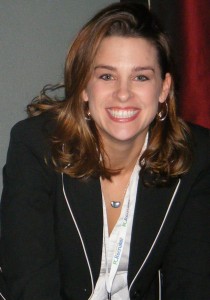 Getting SourceCon NYC kicked off today, Megan Holte, Sourcing and Pipeline Manager at ADP, showed a video of TCU’s Amon G. Carter stadium demolition this past December. The old stadium was functional, but the decision was made to implode sections of it to build it back up and enhance football fans’ experience and upgrade amenities.
Getting SourceCon NYC kicked off today, Megan Holte, Sourcing and Pipeline Manager at ADP, showed a video of TCU’s Amon G. Carter stadium demolition this past December. The old stadium was functional, but the decision was made to implode sections of it to build it back up and enhance football fans’ experience and upgrade amenities.
Holte asked this question: “Why would a team headed to the Rose Bowl blow up its stadium?”
The reason she showed this video was to demonstrate that a good thing sometimes needs to be broken down and rebuilt in order to become great. In her presentation, Holte shared how her sourcing team at ADP was “broken” in order to take it to the next level of success.
In her keynote presentation today, Holte said the price of maintaining status quo was too high. They knew they wanted to be better than where they were going. Some of the things that Holte and ADP pinpointed that needed to be changed included:
- Establishing a single point of contact intake — rather than having sourcers reporting to business units, they would all report to sourcing managers and essentially be centralized.
- Aligning regional and functional sourcing. Some people would need to work in specific regions, some with specific functions.
- Making the sourcing role a pay-for-performance role.
- Role clarity — the perception was that sourcing was an administrative role.
In order to accomplish these and other goals, ADP had to break down its current sourcing structure, which was functional, to build it again to be even better. Going from good to great is never easy — change is hard. When things are going well, why change?
Holte and her sourcing team began exploring new ways of approaching their function:
- They divided their sourcing roles into two specializations: a Sourcing and Market Research Specialist, with focus on geographic alignment, and a Talent Acquisition Sourcer who would focus on building functional talent pipelines.
- They set about creating job description templates in order to create more continuity for their opportunities from a candidate perspective.
- They created a “Tools Team” which reviews new technology resources and provides feedback and analysis to the rest of the team on what’s hot and what’s not.
- They partnered their U.S.-based sourcing team with their India-based sourcing team to create more team unity and establish better lines of communication.
- Establishing a req load of six reqs per sourcer — this proved to be a difficult conversation that Holte had to have with recruiters, but she wanted them to understand the extra time that would be needed to effectively source and identify the right talent.
Additionally, Holte emphasized the need to share successes throughout the team. This is something that many of us need to establish within our own organizations — teams that celebrate each other’s success develop more unity and a desire to help each other achieve success, both individually and as a team.
Holte shared the need for measuring metrics in order to show that this change would take their team from good to great. They began measuring “time to find,” which, coupled with the new job description templates, helps them to prepare for often-worked on positions and set expactations for their hiring managers. On a quarterly basis, both sourcers and recruiters fill out surveys on how their working relationships are. This helps them pinpoint challenge areas and ensure that communication between sourcer and recruiter is open and beneficial. Team accountability is noticeable through what Holte described as “pro roles,” which are small teams that the ADP sourcers get to choose for themselves and through which team members educate one another on various internal and external topics. Teammates are essentially responsible for each other’s continuing education.
Bringing the session back to the TCU stadium implosion…with TCU, who by the way won the Rose Bowl this year, the decision to destroy a perfectly functional stadium was not an easy one, but it needed to be done to make the enhancements they wanted to make it great. Holte shared how, though at times a painful process, the changes needed to be made with ADP’s sourcing team in order to not settle for status quo. And they’ve quite obviously paid off — through quadrupled productivity, more team cohesion, proof in the process through improved metrics, and satisfied, happy hiring managers.